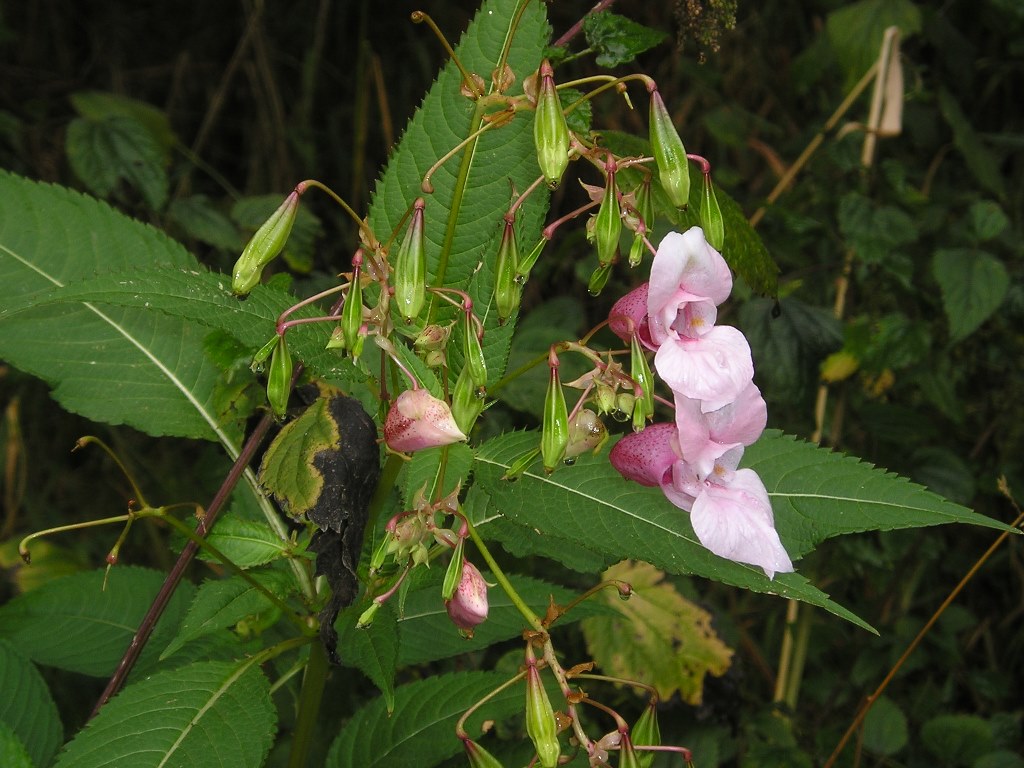Policeman’s helmet (Impatiens glandulifera) is an invasive annual which threatens streams and rivers throughout the Pacific Northwest. It is designated as a Class B invasive weed in Oregon. This means that it is a weed of economic importance which is regionally abundant, but may have limited distribution in some counties. Policeman’s helmet has been identified and treated in Clackamas County, so please be on the look out for it.
Native to India, this showy, purple-flowered invasive weed was originally introduced as an ornamental plant. It is highly invasive and forms dense patches wherever it occurs. Look for it in ditches, wetlands, and along waterways.
How Can I Identify Policeman’s Helmet?
Also known as jewelweed or Himalayan balsam, policeman’s helmet grows quickly and produces attractive purple, pink, or white flowers. It has naturalized quickly here in the Pacific Northwest and now dominates streamside vegetation in many areas.
This aggressive invasive germinates in early spring and can grow up to ten feet tall. The large, upright, reddish stems are hollow and topped with dangling, tubular flowers in showy clusters. Leaves are oblong with serrated edges and a reddish tint.
Why Should I Care About Policeman’s Helmet?
Did we mention that it is aggressive? A single plant can produce up to 800 seeds which are easily carried downstream in flowing water to start a new infestation. Mature seed pods can propel seeds up to 20 feet away, displacing native vegetation along stream sides by forming tall, dense stands which shade out competition from other, more beneficial plants.
This aggressive nature leads to a negative impact on our streams and rivers. When policeman’s helmet dies back in the fall, it leaves streamside soils exposed and unprotected. The result is increased streambank erosion and decreased water quality when water levels in our streams begin to rise in the winter. Additionally, the soil from the exposed banks is deposited on the stream beds, smothering fish eggs and degrading habitat for other aquatic animals.
How Can I Control Policeman’s Helmet?
Policeman’s helmet has a shallow root system and grows in moist soil, so it is easily pulled by hand, but be sure to remove the entire root! Pulled plants may be composted on site if flowers have not fully formed. Any flowers and immature seed heads should be removed, bagged, and placed in the municipal waste.
Do not pull or move through areas infested with policeman’s helmet when the seed heads are popping! Check and clean clothes, pets, equipment, and vehicles to prevent the spread of this invasive weed.
Report Policeman’s Helmet!
Have you noticed invasive policeman’s helmet in your area? If so, please report your sightings to the District’s WeedWise program by giving them a call at 503-210-6000, or submit your information online to the Oregon Invasive Species hotline. Your help in identifying and reporting locations of policeman’s helmet in our community will provide early detection information to the experts working to stop the next invasion before it starts!
Learn More
For more information about policeman’s helmet, check out these resources:
-
Plants Profile for Impatiens glandulifera (policeman’s helmet)
-
Policeman’s helmet profile – State of Oregon
-
Policeman’s helmet– Washington State Noxious Weed Control Board
-
Invasive Species Compendium Datasheet- Impatiens glandulifera (Himalayan balsam)
-
Policeman’s helmet – King County

Our mission: We help people conserve and use natural resources sustainably today and for future generations.



